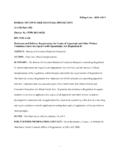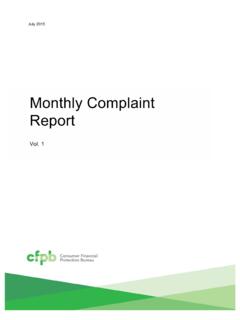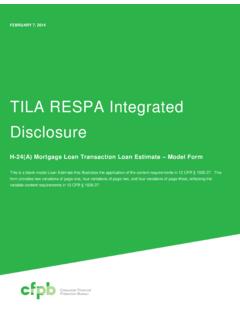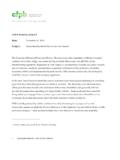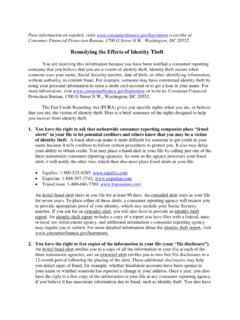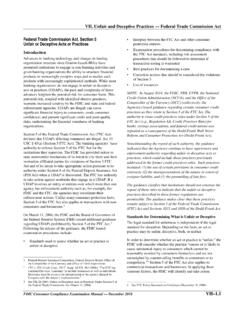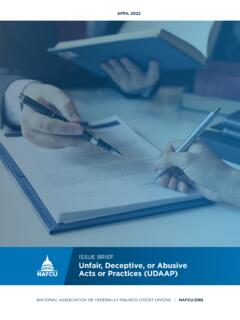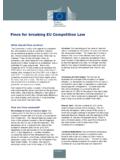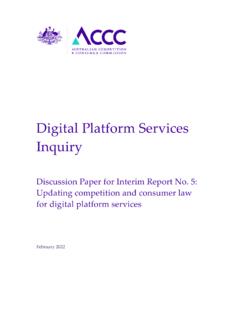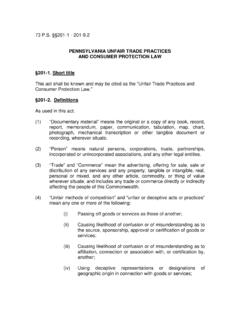Transcription of CFPB Consumer Laws and Regulations UDAAP
1 CFPB Consumer Laws and Regulations UDAAP . unfair , Deceptive, or Abusive Acts or Practices unfair , deceptive, or abusive acts and practices (UDAAPs) can cause significant financial injury to consumers, erode Consumer confidence, and undermine the financial marketplace. Under the Dodd-Frank Act, it is unlawful for any provider of Consumer financial products or services or a service provider to engage in any unfair , deceptive or abusive act or practice. 1 The Act also provides CFPB with rule-making authority and, with respect to entities within its jurisdiction, enforcement authority to prevent unfair , deceptive, or abusive acts or practices in connection with any transaction with a Consumer for a Consumer financial product or service, or the offering of a Consumer financial product or service. 2 In addition, CFPB has supervisory authority for detecting and assessing risks to consumers and to markets for Consumer financial products and services.
2 3. As examiners review products or services, such as deposit products or lending activities, they generally should identify the risks of harm to consumers that are particular to those activities. Examiners also should review products that combine features and terms in a manner that can increase the difficulty of Consumer understanding of the overall costs or risks of the product and the potential harm to the Consumer associated with the product. These examination procedures provide general guidance on: The principles of unfairness, deception, and abuse in the context of offering and providing Consumer financial products and services;. Assessing the risk that an institution's practices may be unfair , deceptive, or abusive;. Identifying unfair , deceptive or abusive acts or practices (including by providing examples of potentially unfair or deceptive acts and practices); and Understanding the interplay between unfair , deceptive, or abusive acts or practices and other Consumer protection statutes.
3 unfair Acts or Practices The standard for unfairness in the Dodd-Frank Act is that an act or practice is unfair when: (1) It causes or is likely to cause substantial injury to consumers;. (2) The injury is not reasonably avoidable by consumers; and 1. Dodd-Frank Act, Title X, Subtitle C, Sec. 1036; PL 111-203 (July 21, 2010). 2. Sec. 1031 of the Dodd-Frank Act. The principles of unfair and deceptive practices in the Act are similar to those under Sec. 5 of the Federal Trade Commission Act (FTC Act). The Federal Trade Commission (FTC) and federal banking regulators have applied these standards through case law, official policy statements, guidance, examination procedures, and enforcement actions that may inform CFPB. 3. Dodd-Frank Act, Secs. 1024; 1025(b)(1); 1026(b) of the Act. CFPB Manual (October 2012) UDAAP 1. CFPB Consumer Laws and Regulations UDAAP .
4 (3) The injury is not outweighed by countervailing benefits to consumers or to competition. 4. The act or practice must cause or be likely to cause substantial injury to consumers. Substantial injury usually involves monetary harm. Monetary harm includes, for example, costs or fees paid by consumers as a result of an unfair practice. 5An act or practice that causes a small amount of harm to a large number of people may be deemed to cause substantial injury. Actual injury is not required in every case. A significant risk of concrete harm is also sufficient. However, trivial or merely speculative harms are typically insufficient for a finding of substantial injury. Emotional impact and other more subjective types of harm also will not ordinarily amount to substantial injury. Nevertheless, in certain circumstances, such as unreasonable debt collection harassment, emotional impacts may amount to or contribute to substantial injury.
5 Consumers must not be reasonably able to avoid the injury. An act or practice is not considered unfair if consumers may reasonably avoid injury. Consumers cannot reasonably avoid injury if the act or practice interferes with their ability to effectively make decisions or to take action to avoid injury. Normally the marketplace is self-correcting; it is governed by Consumer choice and the ability of individual consumers to make their own private decisions without regulatory intervention. If material information about a product, such as pricing, is modified after, or withheld until after, the Consumer has committed to purchasing the product; however, the Consumer cannot reasonably avoid the injury. Moreover, consumers cannot avoid injury if they are coerced into purchasing unwanted products or services or if a transaction occurs without their knowledge or consent.
6 A key question is not whether a Consumer could have made a better choice. Rather, the question is whether an act or practice hinders a Consumer 's decision-making. For example, not having access to important information could prevent consumers from comparing available alternatives, choosing those that are most desirable to them, and avoiding those that are inadequate or unsatisfactory. In addition, if almost all market participants engage in a practice, a Consumer 's incentive to search elsewhere for better terms is reduced, and the practice may not be reasonably avoidable. 6. The actions that a Consumer is expected to take to avoid injury must be reasonable. While a Consumer might avoid harm by hiring independent experts to test products in advance or by bringing legal claims for damages in every case of harm, these actions generally 4. The standard for unfairness in the Dodd-Frank Act has the same three-part test as the FTC Act.
7 This standard was first stated in the FTC Policy Statement on Unfairness (Dec. 17, 1980), available at: Congress later amended the FTC Act to include this specific standard in the Act itself. 15 45(n). 5. FTC Policy Statement on Unfairness, at p. 3. 6. See Credit Practices Rule, 49 Fed. Reg. 7740, 7746 (1984). CFPB Manual (October 2012) UDAAP 2. CFPB Consumer Laws and Regulations UDAAP . would be too expensive to be practical for individual consumers and, therefore, are not reasonable. The injury must not be outweighed by countervailing benefits to consumers or competition. To be unfair , the act or practice must be injurious in its net effects that is, the injury must not be outweighed by any offsetting Consumer or competitive benefits that also are produced by the act or practice. Offsetting Consumer or competitive benefits of an act or practice may include lower prices to the Consumer or a wider availability of products and services resulting from competition.
8 Costs that would be incurred for measures to prevent the injury also are taken into account in determining whether an act or practice is unfair . These costs may include the costs to the institution in taking preventive measures and the costs to society as a whole of any increased burden and similar matters. Public policy, as established by statute, regulation, judicial decision, or agency determination, may be considered with all other evidence to determine whether an act or practice is unfair . However, public policy considerations by themselves may not serve as the primary basis for determining that an act or practice is unfair . Examples The examples described below stem from federal enforcement actions. They provide insight into practices that have been alleged to be unfair by other regulators and may inform CFPB's determinations. However, the particular facts in a case are crucial to a determination of unfairness.
9 It is important to bear in mind that a change in facts could change the appropriate determination. Moreover, the brief summaries below do not present all of the material facts relevant to the determinations in each case. The examples show how the unfairness standard may be applied. Refusing to release lien after Consumer makes final payment on a mortgage. 7 The FTC. brought an enforcement action against a mortgage company based on allegations, described below, that repeatedly failed to release liens after consumers fully paid the amount due on their mortgages. Substantial injury. Consumer 's sustained economic injury when the mortgage servicer did not release the liens on their properties after the consumers had repaid the total amount due on the mortgages. Not outweighed by benefits. Countervailing benefits to competition or consumers did not result from the servicer's alleged failure to appropriately service the mortgage loan and release the lien promptly.
10 7. FTC v. Capital City Mortgage Corp., Civil No. 98 CV-237 ( Feb. 2005), available at CFPB Manual (October 2012) UDAAP 3. CFPB Consumer Laws and Regulations UDAAP . Not reasonably avoidable. Consumers had no way to know in advance of obtaining the loan that the mortgage servicer would not release the lien after full payment. Moreover, consumers generally cannot avoid the harm caused by an improper practice of a mortgage servicer because the servicer is chosen by the owner of the loan, not the borrower. Thus, consumers cannot choose their loan servicer and cannot change loan servicers when they are dissatisfied with the quality of the loan servicing. Dishonoring credit card convenience checks without notice. 8 The OTS and FDIC brought enforcement actions against a credit card issuer that sent convenience checks with stated credit limits and expiration dates to customers.


